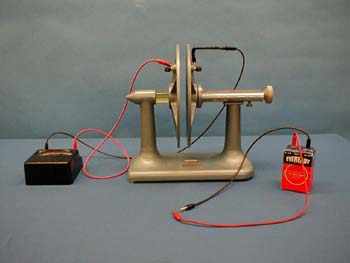Demos: 5A-28 Parallel Plate Capacitor

Two metal plates are mounted such that their plane surfaces are parallel and the plates are insulated from each other. The size of the gap between the plates is variable. The two plates are connected electrically to a projection voltmeter. One of the plates is charged, using an ebonite rod and fur. The voltmeter reading is monitored as the gap between the plates is varied, illustrating that the capacitance, C, is inversely related to d, the separation distance, i.e.
Directions: Separate the plates by a cm or so and attach the leads to the voltmeter. Charge one plate until an easily visible reading is obtained, approximately mid-value. Turn the knob to change the plate separation. (It may be difficult to get quantitative data if charge leakage is a problem.)
Suggestions for Presentation: Review the formula for capacitance of parallel plates. Ask what variable remains constant (in principle) and what should happen when the other variable is changed. How does the predicted decrease in capacitance, for example, result in an increase in potential?
Applications:
Last Updated: Nov 30, 2023 11:25 AM